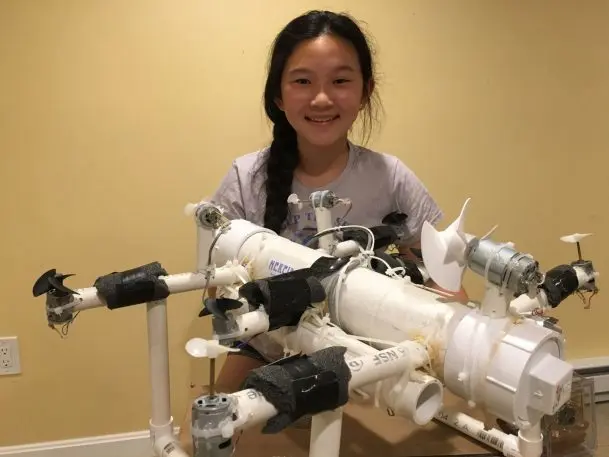Of the millions of metric tons of plastic that enter the ocean each year, researchers don’t yet know exactly where it all ends up. Some of the trash makes it to swirling gyres like the Great Pacific Garbage Patch, which is now thought to be roughly three times the size of France. Some of it is eaten by baby seabirds or whales (when a whale recently died on a beach in Thailand, the autopsy found around 17 pounds of plastic inside the animal). Some of it sinks down to rest on the ocean floor. But one researcher studying ocean plastic says that scientists don’t know the location of around 99% of the waste.
As scientists begin to track ocean plastic from airplanes and even from space, a 12-year-old inventor hopes to help the effort with a device of her own: a robot that can move through the ocean identifying plastic, and that could eventually collect it as well.
“I have always loved marine animals and walking around the beach,” says Anna Du, a sixth-grader from Andover, Massachusetts, who is a finalist in the Discovery Education 3M Young Scientist Challenge. “One day I just noticed that there are plastics everywhere around Boston Harbor, and so I tried to pick them up and clean it up. But there were just so many that I wanted to make something to help that problem.”

She also wants to later create a machine that can capture and remove the plastic it finds, aiming to make “the most efficient machine cleaning up plastics.” Du is six years younger than Boyan Slat was when he talked about a similar goal; Slat’s Ocean Cleanup machine recently completed a test off the coast of San Francisco and is preparing to sail to the Great Pacific Garbage Patch this summer.
Du is one of 10 finalists in the Discovery Education 3M Young Scientist Challenge. Among others, they include 14-year-old Cameron Sharma, who invented an algorithm that identifies personalized flu vaccines using artificial intelligence and machine learning, and 14-year-old Krish Wadhwani, who invented a medication that could potentially cure Huntington’s disease.
Recognize your brand’s excellence by applying to this year’s Brands That Matter Awards before the early-rate deadline, May 3.
